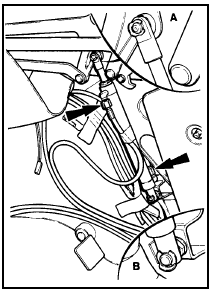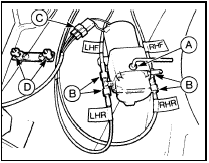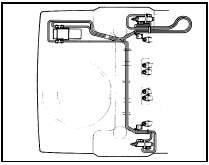Power-operated folding roof components - removal and refitting
Hydraulic rams
Removal
1 Remove the rear wheelhouse covers with
reference to Section 32.
2 Mark the two hoses connected to the ram as a guide to reassembly, then remove the circlips securing the ram to the two studs on the framework.
3 Release residual pressure in the system by opening the filler plug on the pump body.
4 Loosen the hydraulic unions on the ram, then remove the ram from the studs and lay it in a suitable container in the boot. Undo the unions and catch the hydraulic fluid in the container (see illustration).

24.4 Power-operated folding roof hydraulic ram assembly - hydraulic unions
(arrowed) A and B Upper and lower clips
5 If the unions are to remain disconnected for any length of time, cover the ends to prevent dirt entering the system.
Refitting
6 Refitting the ram is a reversal of removal,
noting that the large circlip is fitted to the
lower stud.
7 On completion, fill and bleed the system as described in Section 23.
Hydraulic ram upper pivot stud
Removal
8 Should the hydraulic ram pivot stud break
in service it can be renewed as follows.
9 Open the tap on the hydraulic pump, then manually open the roof halfway.
10 Using a mole wrench, remove the broken end of the pivot stud from the framework. If the remaining stud is too short it may be possible to remove it using a proprietary stud extractor kit.
Refitting
11 De-grease the threads on the new stud,
apply locking compound to them, then fit the
stud and tighten it securely.
12 Refit the hydraulic rams as described previously in this Section.
Pump
Removal
13 Disconnect the battery, then pull down
the pump cover in the boot and open the
bypass valve by 90 to 180 degrees. Do not
open it any further.
14 Open the roof manually.
15 Remove the floor panel and left-hand wheelhouse panel from the boot. This involves propping open the boot lid and disconnecting the supporting gas strut from the lower balljoint.
16 Release residual pressure in the system by opening the filler plug on the pump.
Tighten the plug when the pressure has been released.
17 Disconnect the electrical lead to the pump.
18 Remove the nuts securing the pump to the boot floor, and place the pump in a suitable container to catch the fluid which will be spilt when the pump hoses are disconnected.
19 Mark the hoses as a guide to reassembly, then undo their connections (see illustration).
Cover the open ends if they are to remain disconnected for any length of time.

24.19 Power-operated folding roof fluid pump removed from mounting with hoses
marked
A Filler plug
B Hydraulic unions
C Wiring plug
D Pump mountings
Refitting 20 Refitting is a reversal of removal.
21 On completion, fill and bleed the system as described in Section 23.
Hydraulic hoses
Removal
22 Renewing the hydraulic hoses involves
disconnecting the relevant hose connections
from the pump or ram (see earlier
paragraphs), noting its routing, and where it is
clipped or taped to other components (see
illustration).

24.22 Routing of power-operated folding roof hydraulic hoses
Refitting 23 Refit in the reverse order to removal.
24 On completion, fill and bleed the system as described in Section 23.
See also:
Hydraulic unit accumulator (ABS) - removal and refitting
Note: A new O-ring must be used between
the accumulator and the hydraulic unit on
refitting.
Caution: Refer to the
precautions in Section 1.
Removal
1 Disconnect the battery negative lead.
2 De ...
Crankshaft front oil seal - renewal
1 Disconnect the battery negative lead.
2 Slacken the alternator mounting and
adjuster bolts and after pushing the alternator
in towards the engine, slip off the drivebelt.
3 Unscrew and remove th ...
Door window regulator - removal and refitting
Removal
1 Remove the door inner trim panel.
2 Where necessary for improved access, peel
back the waterproof plastic sheet from the
door.
3 Lower the window until the lower support
channel is vis ...
